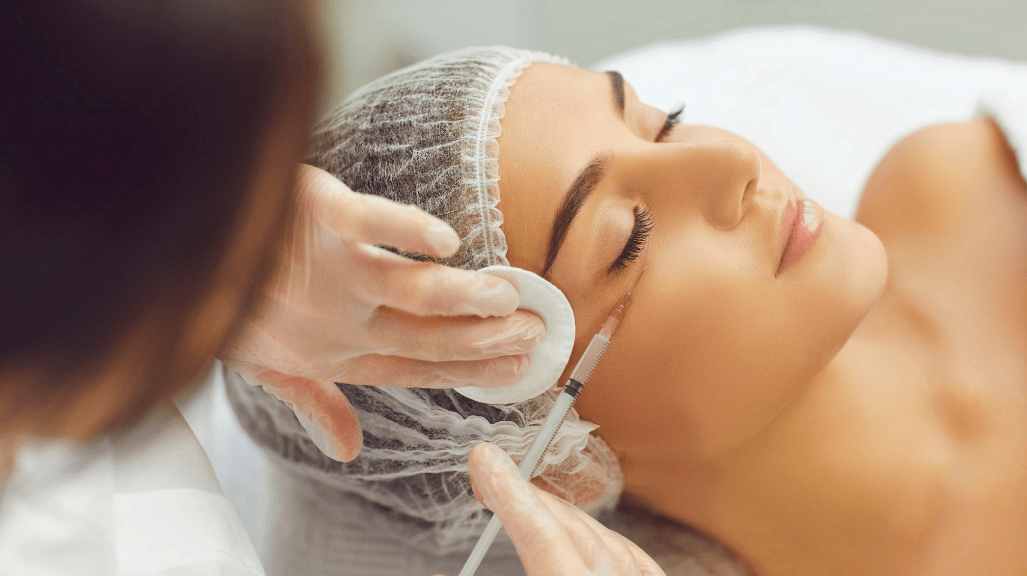By Dr. Sarah Bennett, NMD / August 7, 2019

Many people think that treatments like Botox are reserved for celebrities or people who live in big areas, but it’s actually becoming increasingly popular and even available in places like Scottsdale, Arizona!
The more these treatments and others like it become available, the more likely you will be able to find a quality practice to offer them at a fair price (and without a ridiculously long waiting period for your appointment).
That said, there may be a variety of other reasons that you haven’t sought out a provider yet. Perhaps you’ve heard some negative stories, or maybe you simply don’t feel like you know enough about injections like Botox in the first place.
The good news is that you aren’t alone! With most of the resources out there being biased accounts or extreme stories, it’s normal to hesitate or feel like you don’t have all the facts, so research is always a great first step!
So, what is Botox? What should you look for and what should you avoid? Find out the most important points in this ultimate 2019 guide!

Growing up, I always heard phrases like, “Don’t make that face! It’ll stay that way!” Well, as it turns out, the old saying is true. The expressions we consistently make cause damage to our skin over time and cause unwanted lines and wrinkles, much like the creases that can be made after folding a paper over and over.
Botox and similar injections are neuromodulators primarily used to treat wrinkles and other unwanted lines that form on your face over the years.
To put it in medical terms, neuromodulators utilize a small protein of the botulinum toxin which inhibits acetylcholine transmission, ultimately decreasing neuromuscular function in the muscles treated.
To help simplify that, neuromodulators work by relaxing the muscles that are responsible for the lines or wrinkles in your face. When the muscles relax after treatment, they gradually allow the overlying skin to take on a smoother, less wrinkled appearance.
This also allows the skin to heal from mild damage caused by repeated facial expressions that cause crease in the skin.
Some of the areas treatable by Botox include:
Botox treatments can also be preventative rather than just a solution to already existing problems, so starting treatments around age 27-30 is both normal and recommended. Collagen is a key component of youthful skin that begins to break down in our mid to late 20s and lead to wrinkles, so starting early is in anyone’s best interest!
If you are new to Botox, you may be wondering what to expect (especially since you’ve probably stumbled upon a variety of different biased reviews and opinions).
Typically, one treatment will last 3-4 months (depending on how quickly you individually metabolize Botox and how much you receive during treatment). The amount you will need is based upon the strength of your facial muscles and the look desired.
Due to the variation in doses and specific application, it’s important to make sure you find a physician who not only has experience in your specific concerns but is also willing to openly walk you through the process and truly learn your preferences before they begin.
Continual treatments will help to weaken the muscle and cause less expressiveness, meaning less damage to the skin.
If this is a solely preventative endeavor, you may notice slight changes but should mostly be prepared to not suffer from the formation of dramatic lines and wrinkles. If you already have fine lines, Botox facilitates healing by relaxing the muscle for an extended period of time.
Once you receive your treatment, be sure to stay upright, avoid laying face down and try to avoid exercise for 12 hours. This is to prevent spreading the Botox to undesired areas and to help avoid unwanted side effects.
That said, some of the more common side effects can include:
That said, finding an experienced and qualified provider will help you avoid frustrating side effects, so make sure to do your homework before settling on a provider!

As mentioned, there are plenty of misconceptions floating around that are often caused by extreme cases, horror stories or simple misunderstanding that gets perpetuated by uninformed sources who talk on the subject.
To address just a few of these common misconceptions…
At this point in the article, you probably already see the irony in this misconception since injections like Botox typically aim to unfreeze expressions by erasing lines and other evidence of repeated faces.
That said, since Botox does relax your facial muscles, having too much administered can result in that stereotypical, frozen look that people will often tease in movies or tabloids.
By simply having a quality provider (perhaps even a naturopathic physician with extensive medical knowledge and experience in a range of areas like injections, hormone therapy and more) and making sure you know appropriate limits, this is very easy to avoid.
This belief is probably spread because the word “toxin” is present in botulinum toxin. It is important to note, however, that Botox is the purified protein version of this toxin which makes it largely nontoxic by nature.
Additionally, Botox is injected into your muscles and isn’t systemically absorbed into your bloodstream. You would actually need 200-300 times the number of units of the original toxin to do any damage, so there isn’t anything to worry about here!
As mentioned, trained practitioners have the experience needed to avoid the possible painful side effects like bruising, so if you make sure you are receiving treatment from a qualified practice, you will be okay!
There are plenty of other common misconceptions that may be related to the ones discussed above, but the bottom line is that any qualified practice will not only be able to reassure you, but will also talk through all of the concerns with you to help you better understand it from an experienced medical perspective.
During your search for information on Botox (one of the more recognized injections), you may have stumbled upon other types of injections like Dysport and Xeomin and wondered how they are different.
Botox, Dysport and Xeomin are very similar in the active constituent, treatment process and results, so they are often displayed on med spa menus right next to each other.
They are all Botulinum Type A proteins used to inhibit the acetylcholine transmission and muscle contraction as explained earlier. They mostly differ based on the size of the complexing protein, onset time and the potency per unit.
Botox is bound to be the largest protein, Dysport is a moderately sized protein and Xeomin “pure” is not bound to a complexing protein at all.
What does this all mean? A larger complexing protein may increase the risk of developing antibodies that resist the neuromodulators. This is one of the main reasons that Xeomin may be preferred by patients who have already developed antibodies to Botox and Dysport.
The size of the complexing protein may also contribute to how the neuromodulator spreads once injected. The smaller the protein, the larger the spread! Some say this ability to spread or diffuse through tissue once injected results in a softer appearance, but it also may increase the risk of inhibiting contraction of the wrong muscles and result in things like lip ptosis or eyebrow droop (the most common stereotypical backfires of injections).
In terms of time frames, full results may take up to 2 weeks for all neuromodulators while onset of results are what tend to vary. Both Botox and Xeomin’s onset of results range between three days and one week while Dysport’s onset of results is around 1-3 days after treatment.
Lastly, the neuromodulators will differ in concentration per unit. For instance, you will need 3x more units of Dysport than you will need of Botox. Regardless of neuromodulator, cost per treatment is fairly comparable since Dysport is also much cheaper per unit than Botox.
Ultimately, the best injection for you will depend on your specific situation, so it’s worth booking a consultation with a knowledgeable provider to help determine what would be best for you!

Now that you have a fair understanding of Botox, you may be wondering how to proceed when it comes to finding a good provider who will keep you in mind and deliver great results.
First and foremost, the provider should be able to give you a full medical aesthetics assessment based on your concerns. This is crucial in making sure you get the result you desire because even the most practice hands cannot read your mind and know exactly what you need without a proper assessment!
The provider should also be knowledgeable about any other treatments that may be needed for the face to provide you with optimal results.
During your assessment, they should talk to you about what look you are interested in, how much movement of your muscles you would like to have the treatment and any other basic information that will give them an idea of your situation and desires (not everyone wants the same thing and most people won’t want a completely frozen look).
They should also ask you about the last time you had a neuromodulator treatment. It’s very important not to have treatments more frequently than every three months in order to ensure receptor sensitivity remains intact! We want these treatments to continue to work for us over time, and overdoing it will get in the way of that.
Lastly, they should ask you if you have ever had any bad experiences or adverse reactions to neuromodulator treatments. Everyone’s body is unique and different, so if you responded in an undesirable way, this will help protect you from repeating those side effects.
Most importantly, always feel comfortable asking your practitioner where they were trained and if they went through a certified course.
Not all practitioners offering Botox have had official training, and this can increase the chance of unwanted side effects and results. Certified courses teach practitioners the cutting edge techniques, “no go zones” and the identifying factors of a patient at risk of side effects. Any trained physician will be happy to share their qualifications, so always ask!

While there are many things you should actively be looking for, there are also things that you should make sure to avoid when hunting down the right practice.
Of course, as hinted towards earlier, you should always make sure you have a licensed, qualified provider before anything else. Ask your physician how they are qualified and make sure they are capable, because the “horror stories” that may have had you hesitant about Botox before only happen with unpracticed hands.
Something else to be wary of is extremely low prices. While low prices are typically a good thing, they aren’t always the best sign when it comes to medical procedures (if you’re going to skimp on something to save money, this should not be it).
Low prices or strange business hours (11 p.m. appointment?) can imply that the provider isn’t as qualified as they original lead on, and it’s often best to just stay away from ventures that give you a weird feeling. Of course, there is always the chance that they are giving you a good deal at an oddly flexible hour, but it’s best to not take that chance.
Always, always, always be wary of nonsterile environments. Even if a practice is designed more as a day spa than a clinic, medical procedures should always be done in clearly sterile environments, especially when needles are involved!
Lastly, be sure to either look for “before and after” photos on their websites/review pages or to ask for them if you cannot find them on your own. If a practice is proud of their work, it is pretty common for them to want to show that off and give you an idea of their abilities. For this reason, a venture with little to no photographic evidence of their results might be a little suspicious.
Always be sure to read reviews and to have thorough conversations with your potential providers so that you can keep an eye out for these or any other red flags! And, of course, be sure to go with your gut – if something doesn’t feel right, find a different provider!
Botox and other injections are a great, quick, non-invasive treatments to help all kinds of people achieve their dream skin, and you can be one of them!
By understanding what you should look for and expect, you are already on the way to finding the best provider for you. Now all you have to do is research the best options in your area, schedule some consultations, and track down that perfect fit!
Of course, you can always feel free to ask me any additional questions you may have and I’ll be here to clarify it all and make you feel as prepared as possible as you embark on this journey of renewed confidence!
TOP BOTOX PRACTICES ACROSS ARIZONA:
Hello, my name is Dr. Sarah Bennett, NMD!
I am a naturopathic physician licensed in the state of Arizona currently practicing at my office in Scottsdale, AZ. I received my degree from Southwest College of Naturopathic Medicine, did a year residency at Keystone Natural Family medicine, and received additional training for aesthetics & anti-aging at National Laser Institute.
My passion and fascination for natural medicine began during my undergraduate studies at Indiana University where I got a dual degree in neuroscience & psychology.
I saw how a preventative approach could help you live a long and youthful life. Since then I have dedicated my life to serving others to understand the latest medical trends.
I spend my spare time running, hiking, rock climbing, camping, testing out new diets, and reading books on latest medical trends / listening to podcasts to find the latest nuggets of knowledge to improve the quality of life for my patients. I look forward to serving you!